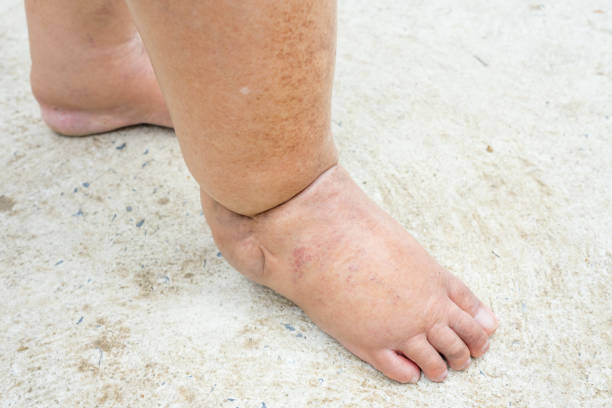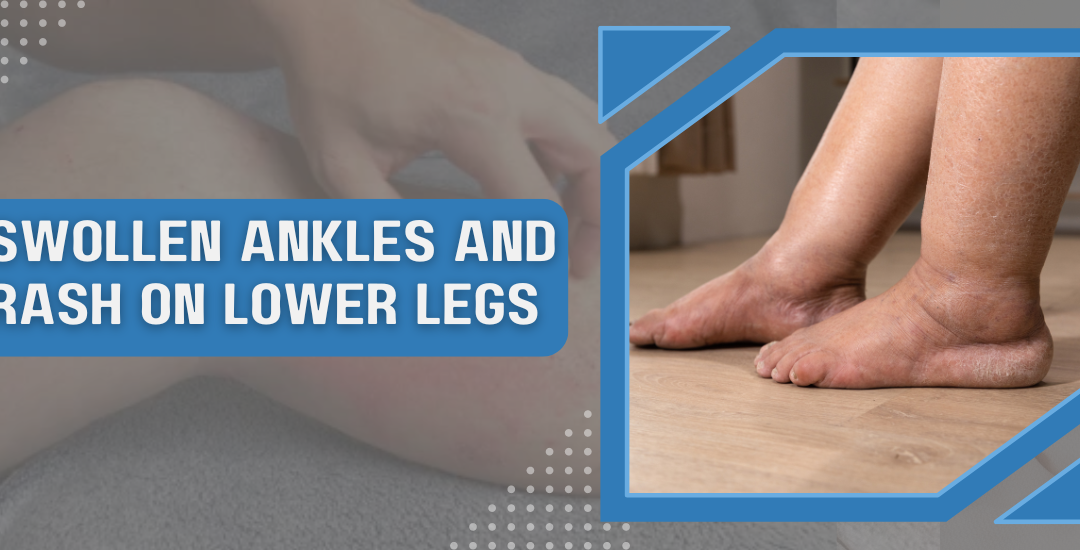Swollen ankles and rash on lower legs can be an uncomfortable and concerning condition that affects many individuals. These symptoms can arise from a variety of causes, ranging from mild to serious. Understanding these signs and seeking appropriate medical advice is crucial for effective management and treatment.

Dr. Archit Aggarwal at KDC Clinic, is a trusted dermatologist in Faridabad. He has a vast amount of experience in diagnosing and treating various skin conditions and related symptoms like swollen ankles and rash on lower legs. He is an expert in helping patients facing such uncomfortable symptoms, ensuring they receive the best care based on the latest medical research and practices.
Ready to learn how you can tackle these symptoms? Contact the clinic for an appointment.
Are you wondering “Why exactly do these symptoms appear? “. Read below to clear your doubts.
Causes
Several things can cause an itchy rash on the lower legs and swollen ankles, each varying in severity.
Venous stasis dermatitis is a common cause where the veins in your legs block the blood flow to the heart. This causes an accumulation of blood in the legs. Which can lead to swelling and rash.
Another common cause is contact dermatitis, where the skin responds to allergens or irritants. It causes rash and swelling if acute. Insect bites and infections can also mimic these symptoms.
Dr. Aggarwal states that “Such a condition can also be caused by environmental factors. For example, exposure to high temperatures and sunlight. This is especially observed in people with sensitive skin or those having pre-existing conditions such as eczema.”
In addition, physical factors such as extended periods of standing or sitting, particularly during long flights or while in the office, can worsen these symptoms.
For better insights from an expert, contact the clinic for an appointment.
But, that’s not all. Keep reading to know what else you should watch out for.
Underlying Conditions
While rash on lower legs and swelling can be due to minor issues, they can also indicate more serious underlying conditions.
Chronic conditions such as liver disease, kidney disease, or heart failure can cause swelling due to fluid retention in the body. This often occurs with other symptoms like tiredness and shortness of breath.

Also, autoimmune diseases, such as lupus or rheumatoid arthritis, often involve swelling and rashes. This happens due to the body’s immune system attacking its tissues.
Another condition can cause swollen ankles and rash on lower legs, such as peripheral artery disease (PAD). This usually results from blocked arteries in the legs. This condition is particularly serious as it can lead to low blood pressure and increase the risk of infection and ulcers in the affected areas.
Accurate diagnosis is as important as the treatment, Consult an expert today.
So, what can be done to treat these issues?
Treatments

The treatment is very much dependent on the kind of underlying cause. In venous insufficiency, wearing compression stockings and lifting the legs can help decrease the swelling. Regarding rashes, it can be treated using topical creams and ointments.
If it’s due to allergies or contact dermatitis. Stay away from the allergen and use topical creams. Furthermore, infections will require antibiotics or antifungal medications.
In the case of chronic conditions such as heart or kidney disease, properly managing the condition is essential. This may include a variety of therapies. For example, medications and treatments to control heart rhythm or kidney function, dietary changes, and fluid management programs.
Dr. Archit Aggarwal, a renowned dermatologist in Faridabad says “ It’s important to maintain open communication so the doctor can identify the right cause and treat accordingly.”
It’s necessary to consult a skin specialist before taking any action, book an appointment today, and find the right treatment.
Moving on, know how you can avoid such symptoms in the first place.
Prevention
Prevention measures are mostly based on lifestyle adjustments and health management. Exercising and maintaining a healthy weight reduces the risk of circulatory disorders that may cause swelling. Likewise, avoiding long periods of sitting or standing will go a long way in preventing these symptoms.
Following a proper skincare routine is also important, especially for those with sensitive skin or existing skin conditions. The use of hypoallergenic products, regular moisturizing, and avoiding exposure to sunlight and harmful substances can prevent dermatological issues.
To those who are at a risk of allergies or contact dermatitis. You should educate yourself about what substances cause allergies and avoid them accordingly. Regular visits to a doctor can also help control any pre-existing conditions that may lead to these symptoms.
Conclusion
Itchy rash on lower legs and swollen ankles are symptoms that should not be ignored. They can indicate both minor and serious health issues. Dr. Archit Aggarwal, a skilled dermatologist in Faridabad, emphasizes the importance of understanding the potential causes and underlying conditions associated with these symptoms for effective treatment and management.
By consistently practicing preventative measures and seeking timely medical advice, individuals can significantly improve their quality of life and prevent the progression of potentially serious conditions. It is always advisable to consult with a healthcare professional, like a dermatologist, to receive a proper diagnosis and appropriate treatment plan tailored to the individual’s specific needs.
If you have more doubts? Refer to some FAQs below.
FAQs
When should I be concerned about swollen feet?
You should seek medical attention if the swelling is persistent, accompanied by pain, or if you experience other symptoms like shortness of breath or chest pain, as these could indicate a serious condition.
What causes a rash on the lower legs?
A variety of factors including dermatitis, allergies, infections, or underlying health issues like venous insufficiency can cause rashes on the lower legs.
How do you treat a rash on your lower legs?
Treatment depends on the cause but may include topical creams, avoiding irritants, and in some cases, prescription medications to address underlying issues.

